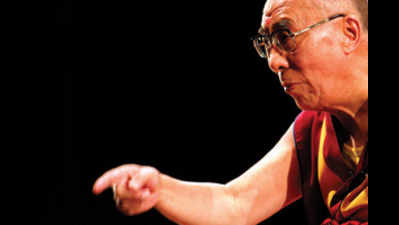Trending
This story is from July 3, 2016
Globally united, locally diverse


Buddham saranam gacchami
Sangham saranam gacchami
Dharmam saranam gacchami
I go for refuge in the Buddha; I go for refuge in the Sangha; I go for refuge in the Dharma
Meet the people who believe that man was created equal and that brotherhood, compassion and moral living sans ritualistic fanfare are key principles for a happy, empowered life. The more educated and philosophically-bent among these also talk about taking refuge in mindful living.
Meet the Buddhist.
It does not matter if one is talking about the Buddhist who has taken refuge in the religion or those who have adopted the methods of the religion. It also does not matter whether one is talking about a Buddhist who practices the Mahayana tradition of the Zen sub-type, or the Theravada Buddhist practising the Ambedkar subtype.
If there was one thing research into the Buddhists of Goa revealed it was this: as a spiritual people they are globally united in their beliefs and in the way they conduct their lives, separated in external appearances only by their native cultural upbringing.
Even though their spirituality, as also seen in other religions, is divided into three main traditions and then into several subtypes, it remains bound by the common denominator of karma, truth, the developing of wisdom and understanding, morality, and being mindful of one’s thoughts and deeds.
Anita Kamath Dudhane, a Dona Paula-based physician, who follows the Mahayana tradition of Buddhism, says, “Buddhism has three main branchesTheravada, Mahayana and Vajrayana. Then, there are many subtypes such as Zen, Nichiren’s group, etc.”
Closer home, the number of Buddhists may not be large, but they are there.
“I practice the Mahayana tradition and there is a group that practices once a week with me. There are also the Vipassana and Soka Gakkai groups, which meet regularly,” Dudhane says, going on to talk about the 300 to 400-odd Tibetans who ebb and flow depending on the tourist season, and thus, contribute to the floating populace of Buddhists in the state.
There is yet another sect of Buddhists in Goa that comprises some 200-plus people whose ancestors followed Ambedkar in embracing the religion.
“It allowed us (dalits) to be recognized as human beings for the first time after centuries of oppression and atrocities,” says writer and senior journalist Dadu Mandrekar, a devout Buddhist, who follows the religion’s principles of conscious breathing, brotherhood and meditation. He converted in 1982 in Mumbai. Mass conversion in Goa happened as late as 1991.
“Ambedkar’s group comes under the Theravada Buddhists, but this was mainly a political movement. Some are slowly coming around to studying the Buddha’s teachings,” Kamath maintains.
Catching up with the Tibetans, who, as one may say, are born into the religion, revealed their incredulity that someone might want to write about their religious beliefs because they make no hue and cry about it. For them, it is a way of life. Karma Dolma, a follower of Vajrayana, says, “We have no big ceremonies. Buddhism does not require them. Our prayers are simple. There is no idol worship. Our offerings are minimalistic.” Offerings, which usually comprise puja flowers, jaggery, ghee, milk and dried fruits, are made at home on a personal level. There is no concept of temple rituals.
The followers of Nichiren Buddhism constitute people of all faiths who live by Sakyamuni Buddha’s penultimate teaching, the Lotus Sutra. In its essence, this practice involves chanting of the phrase, ‘Nam-myoho-renge-kyo’, which, when translated, means, ‘I dedicate my life to the law of cause and effect’. Once again, it is a practice. All are welcome and no religious conversion is involved.
“Most people I know (in Goa) haven’t convertedthey use Buddhist methods like meditation. In fact, the Dalai Lama clearly discourages conversion. He says there is no need to convert to use Buddhist methodology,” Dudhane says.
All sects lay scant emphasis on ceremonies, with Buddha’s anniversary and the date of Parinirvana being the only important dates. “Karma is of paramount importance as it is believed that any good or bad deed is multiplied countless times. So, people watch their actions and try to do charity and personal prayer,” Dudhane explains. Dolma more than agrees.
Buddhism lacks marriage ceremonies as it was essentially a monastic tradition. Mandrekar shares that entering the sanctimony of wedlock is achieved by a simple exchange of garlands over a reading of Pali gatha.
Funeral rites, again, vary according to various traditions. The Tibetan tradition has very complex death ceremonies. They are not always necessary, however, for it is most important to keep a clear mind that is free of attachment, anger and fear at the time of death.
That is how simple it is for the Buddhist, whether he lives in Goa or Timbuktu.
Today, Goan Buddhists may be a miniscule minority, but there was a period in history when the hills of hinterland Goa vibrated to the chanting of Buddhist monks. As a part of India historically, till 1510, Goa was embraced in all the religious waves that swept the subcontinent.
Buddhism, which has a 2,300 year history in Goa, disappeared from the state only sometime around the 12th century, the late archaeologist V R Mitragotri says.
“Buddhist monk Punna,” writes Mitragotri in his PhD thesis, “visited Goa during the lifetime of Buddha itself.”
Sadly, with the end of political patronage somewhere around the 12th century, the chants were forever silenced in the state. Left behind were mute witnessesthe caves that the monks once lived in, such as the ones seen in the villages of Rivona and Lamgao.
Rakesh Mundye & Rajtilak Naik
End of Article
FOLLOW US ON SOCIAL MEDIA










